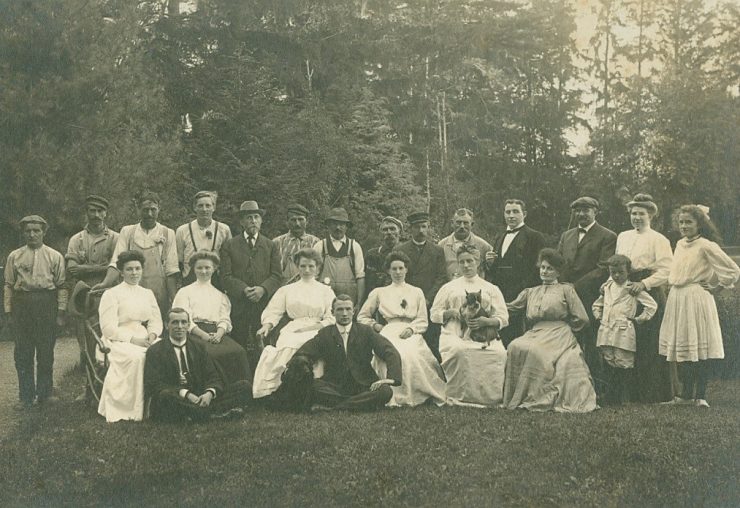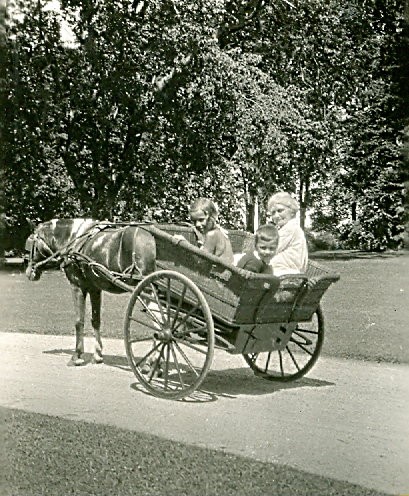Household Staff at Blithewold

Blithewold and other large mansions of its era were designed on the assumption that there would always be a plentiful supply of servants. Bessie Van Wickle McKee could not have maintained her large residences without the hard work, competence, and loyal dedication of several generations of household staff. Some of Bessie’s employees arrived and departed quickly — others stayed with the family for many years. The south wing of Blithewold was the servants’ domain. Besides the kitchens and laundry rooms, this wing housed a servants’ dining room, sitting room, seven bedrooms, and four bathrooms. There were also three staff cottages on the estate to house working couples and their children, and a small cottage by the dock for the captain of the yacht ‘Marjorie’.
WHO WERE THEY?
Like most domestic help in the northeastern United States at the time, most domestic employees at Blithewold were Irish. Millions of Irish immigrants left poverty in their country to seek employment in America. Domestic service provided room and board, security, and a little extra money to send to the family at home. However, they were completely dependent on their employer’s goodwill, and their lives were not without stress. Bessie seems by all accounts a benevolent employer, considerate and fair, and many of her staff remained loyal to her for their entire working lives. Bessie took care of them when they were sick, and made sure their children were educated.
KEY STAFF POSITIONS
The most important members of staff at Blithewold were cook, butler, parlor-maid, laundress, coach-man, and head gardener. All of these positions were filled as early as 1896 when Blithewold was first built. In addition, there was the captain of the yacht ‘Marjorie’ and its crew. Most of the servants lived onsite, though several came in from Bristol on a daily basis, particularly when the house was full of guests. In 1912 there were as many as 15 servants, and by 1920 there were 12 men working on the grounds alone.

KATHARINA GUCK, also known as Katrina, worked for Bessie in Hazleton before Blithewold was built. She was still with the family as late as the mid-1930s and probably only left when Bessie died in 1936. It was Katrina who first noticed the smoke coming from the roof when the old house burned in 1906. Other women employed at Blithewold for many years were Kate Rocher, Maggie Coogan, Mary Chisholm, Mary Dwyer, Tillie McDonnell, and Peggy Devine.
TILLY MCDONNELL, the cook, ruled the kitchen for more than forty years, supervising all the other staff and generally making sure that the household ran smoothly. Tilly looked after Marjorie Lyon in her last years and was still in service when Marjorie died in 1976. She stayed on at Blithewold until it was taken over by the trust. Several members of the family remember how she enjoyed spoiling the children: Marjorie Shaw Jeffries, Bessie’s granddaughter, recalled, “Tilly fussed over whatever children happened to be visiting at Blithewold at any given time … she was always a very special person for me as she loved children and made us her friends. She would escort me through the kitchen and find little goodies along the way.”
FRANK DALLISON, Bessie’s long-time butler, was one of Blithewold’s most colorful characters. He was born in Leeds, England, in 1870, and by 1907 was employed as butler to the McKees. He lived in Bristol and remained in the McKees’ employ until the mid-1930s (probably after Bessie died). Bessie wrote in December 1907 “Dallison is fine — better than Ellis in catering, and I like him personally much better. The household is running very smoothly.” Dallison is said to have been particularly fond of Augustine as she was growing up, enjoying and encouraging her high spirits. He has been described as ‘lofty’ and ‘dignified’, desirable attributes for a proper English butler. However, his reputation was somewhat tarnished by accusations of drunkenness and an undated, unsigned letter to Mr. McKee that reports “goings on in your house while you are away …”
JOHN BEST worked on the grounds at Blithewold from 1898 until his retirement in 1928. He lived in the brown shingled cottage south of the greenhouse known as the North Cottage with his wife and daughter Margaret. He was born in Ireland in 1862 and, after coming to the United States, was a gardener for a local Bristol family. He was hired by Augustus Van Wickle to work at his Hazleton, Pennsylvania home, and returned to Bristol permanently in 1898. He was instrumental in helping to create and maintain the Blithewold landscape designed by John DeWolf.
ARTHUR RAE became Blithewold’s head coachman in 1906. He lived in the south cottage of the garage complex with his wife Ingrid, his son Arthur, and his daughter Eleanor. As means of transportation changed, Arthur Rae developed a great interest in automobiles and became the chauffeur. He was a dedicated, responsible, and adaptable employee, always at the family’s disposal, meeting trains and ferries and keeping track of the voluminous baggage. His duties included driving the family to social engagements, transporting household staff back and forth between family homes in Boston and Bristol, delivering produce from Blithewold’s gardens to the family’s townhouse on Commonwealth Avenue, and the maintenance and fine appearance of Blithewold’s many vehicles. He drove and cared for a succession of large and expensive cars from Simplex and Locomobile to Packard and Cadillac. He ultimately became the estate manager. When Arthur Rae died in 1953 a sequoia was planted at the Congregational Church in Bristol in his memory, and a plaque was installed in the Rose Garden celebrating his 47 years of faithful service to the family.
AUGUST BOTELHO worked for many years as a gardener at Blithewold and lived in the north apartment of the garage complex with his wife Emma, also known as Evelyn. August spent most of his adult life in employment at Blithewold, and when Arthur Rae died he became the estate manager. His priority was the grounds and gardens during the season, and he had the greatest respect for Marjorie Lyon’s horticultural knowledge. During the winter months, he and Emma took care of the mansion while the family was in Boston, supervising special cleaning and polishing and mending of linens in preparation for their return.
